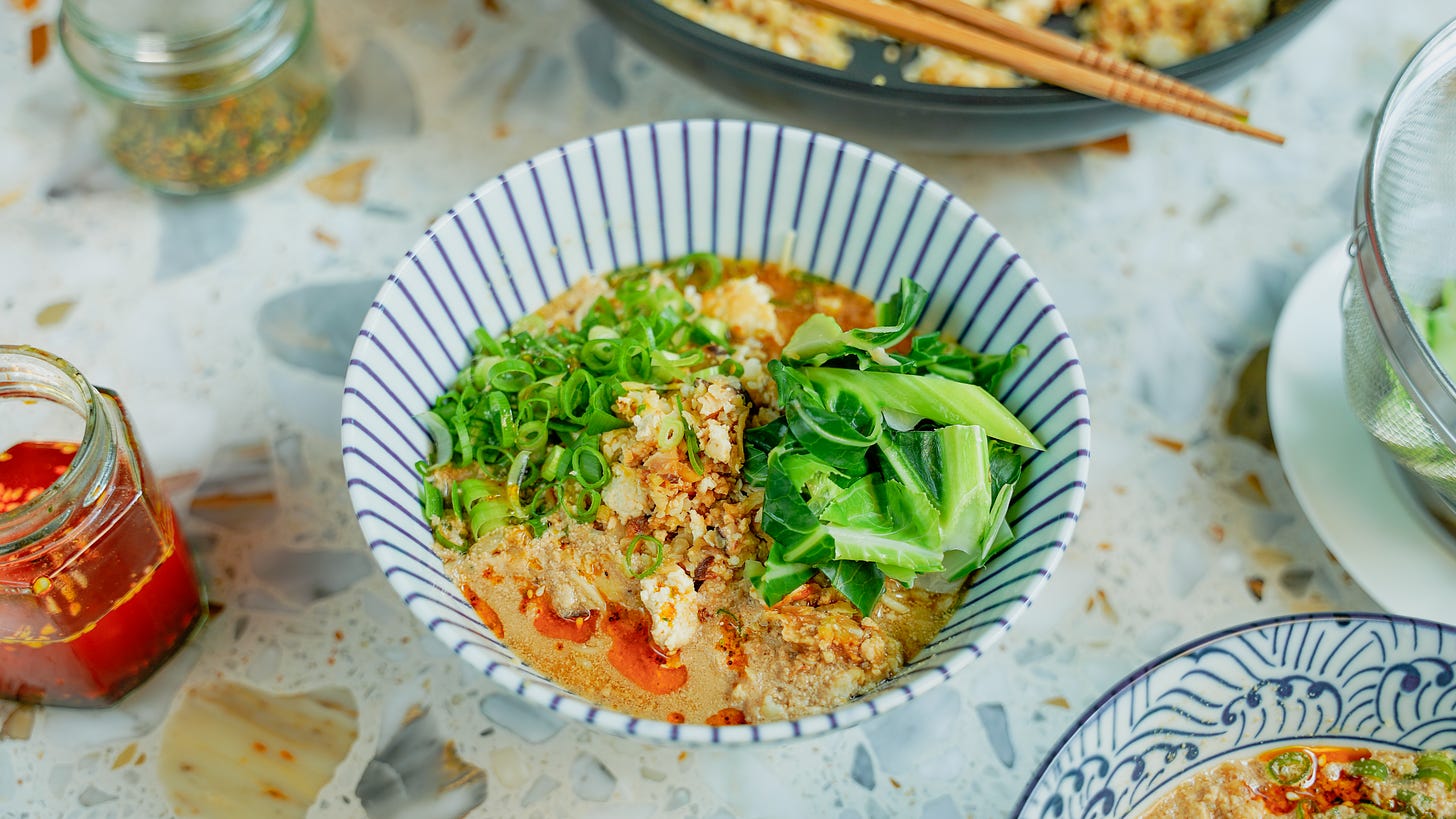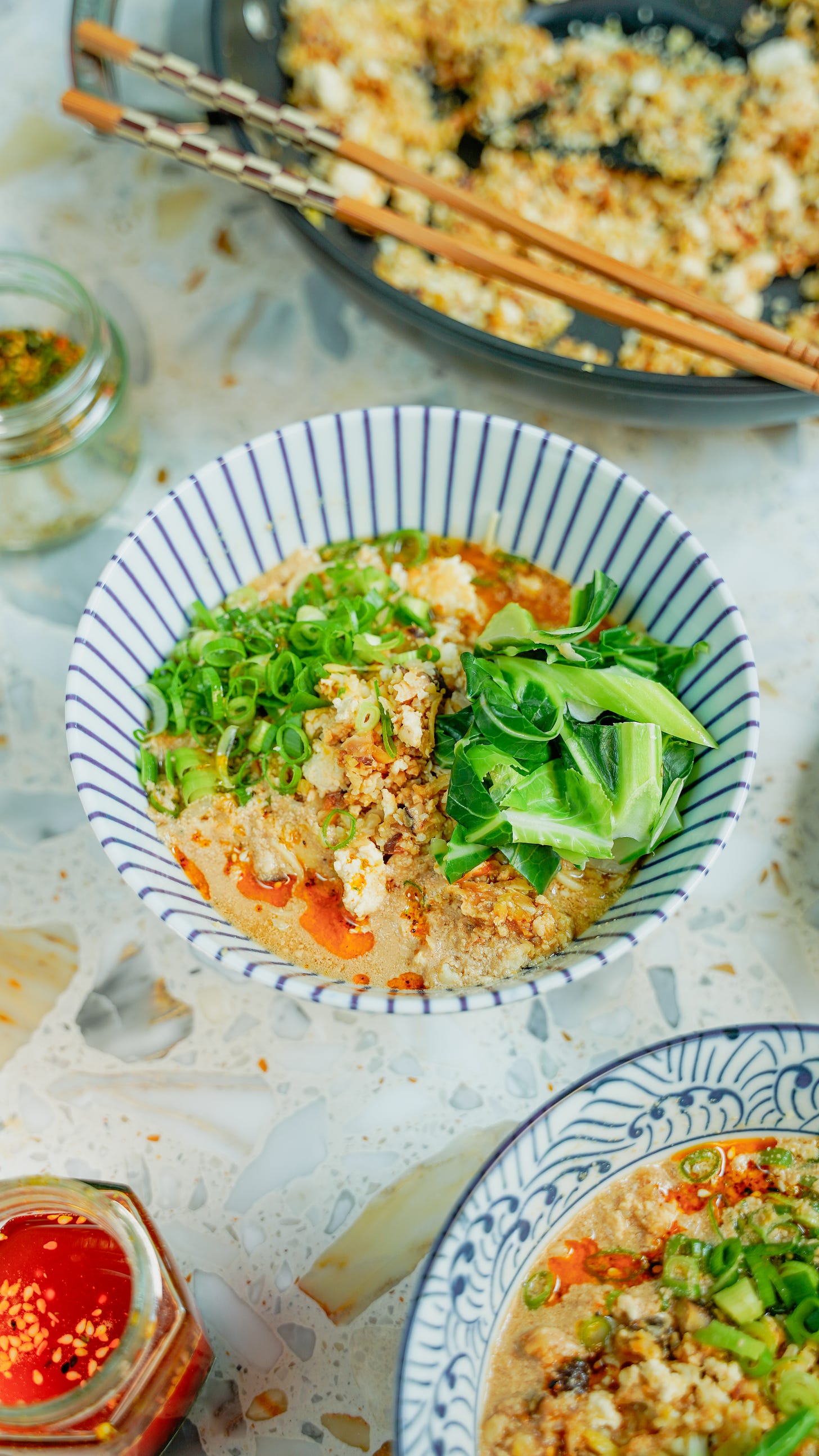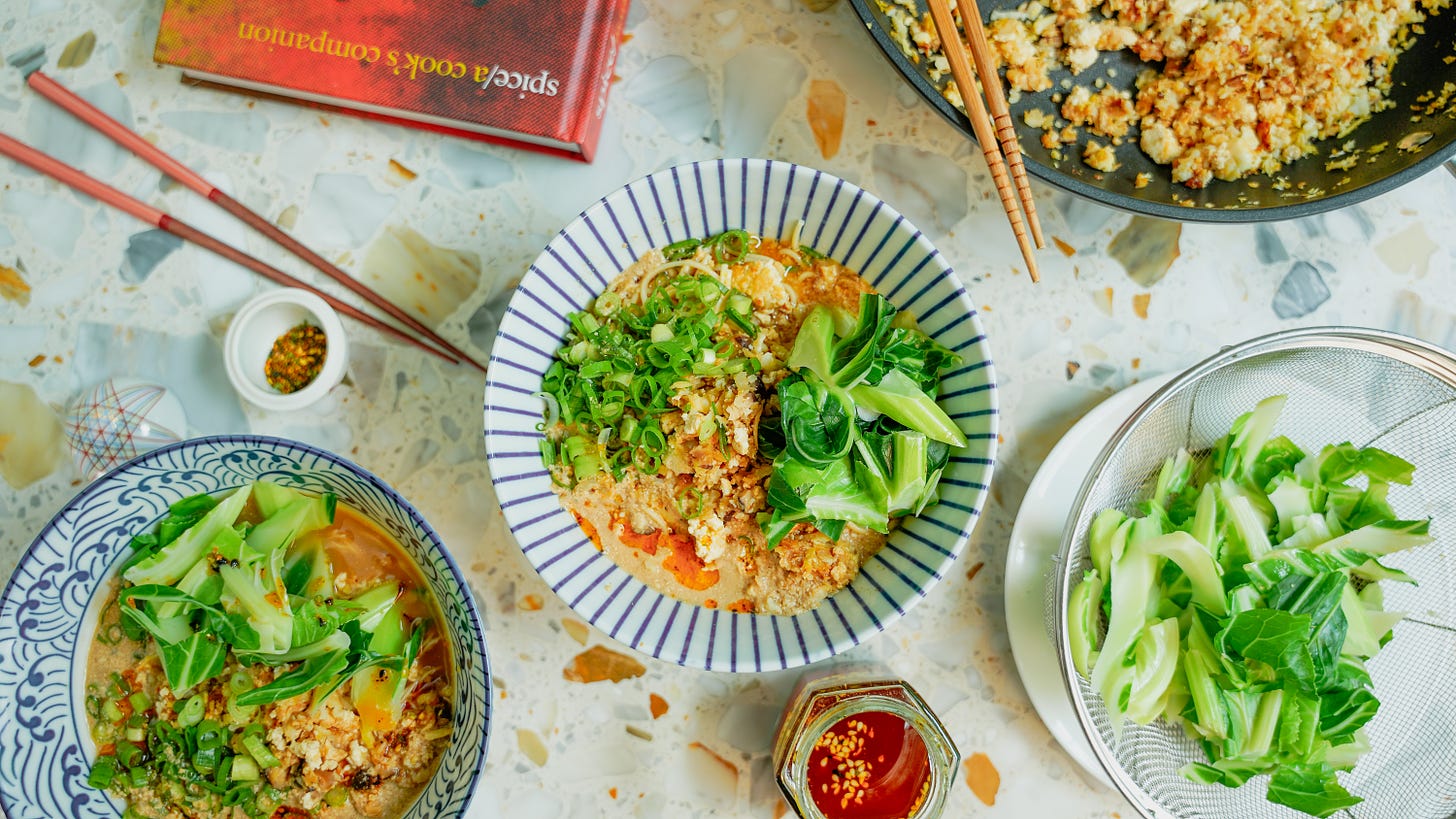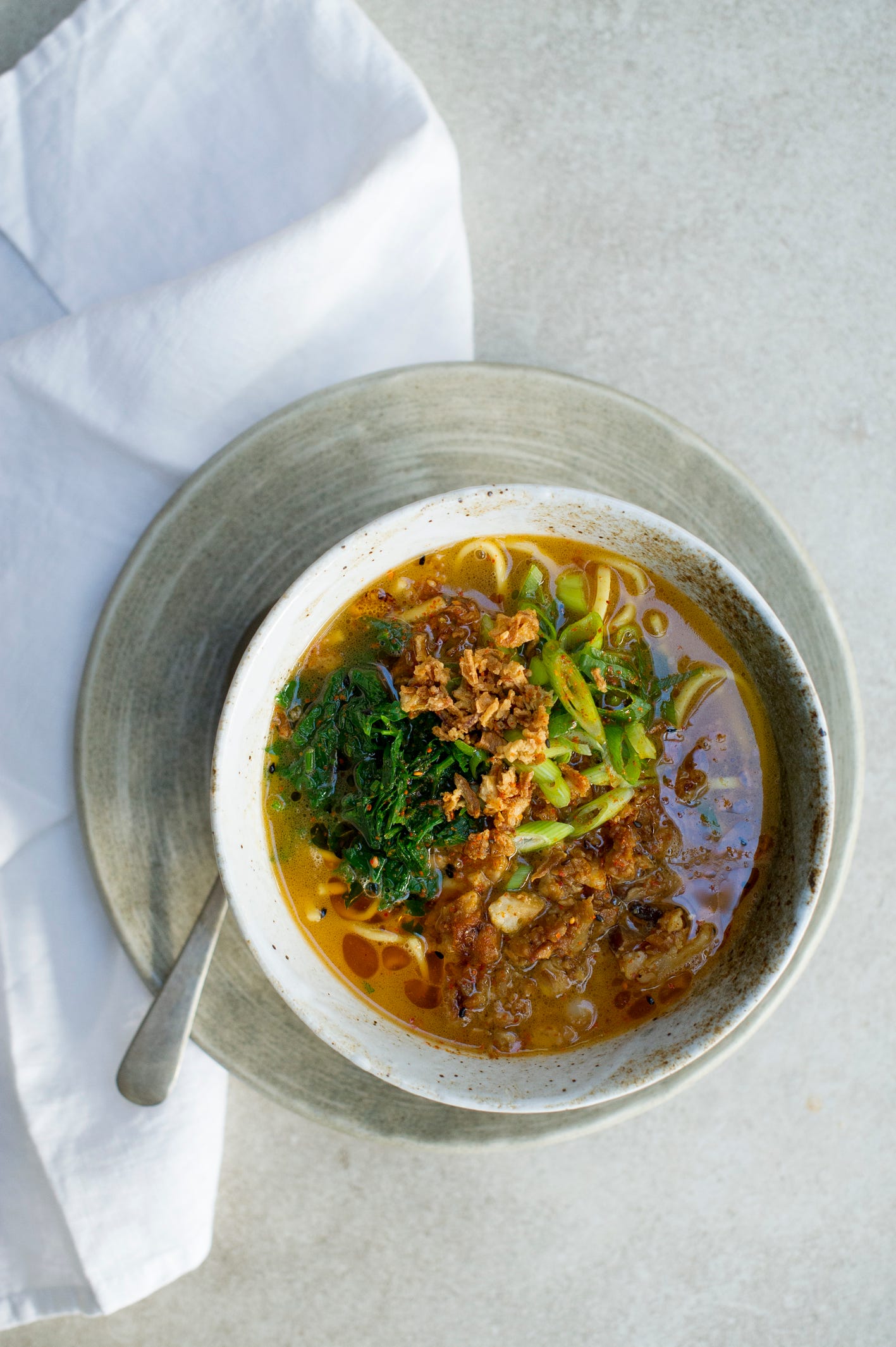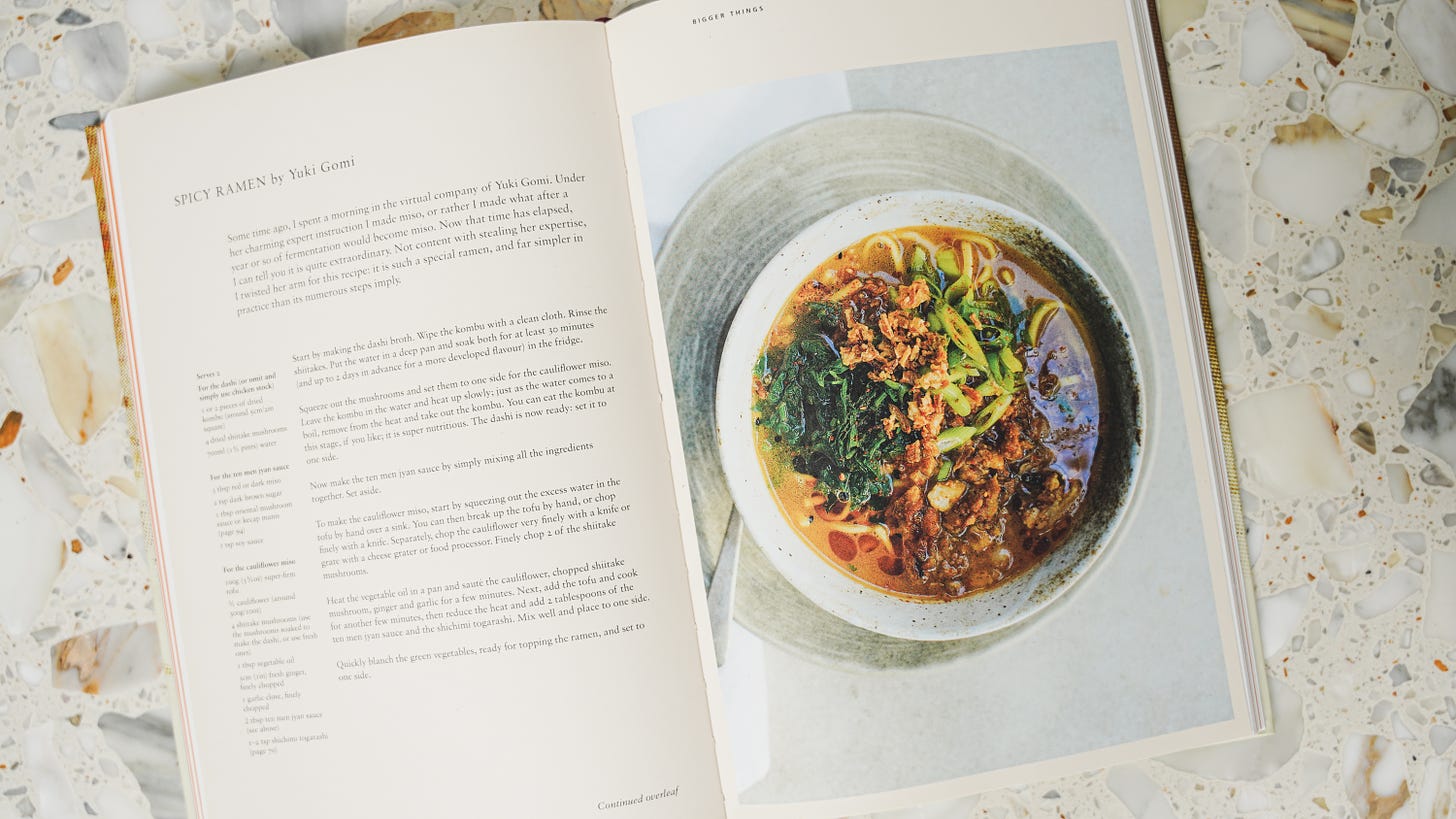

Discover more from Japanese Food. Simply.
Spicy and Rich Tantanmen Style Ramen - BTW It's Vegan.
Achieve a heavenly, rich, creamy ramen in minutes (not hours), via a tahini broth and Japanese spices. Not suitable for Buddhist monks.
Ramen? It’s all about the broth right? I’m sure I’ve written these words myself a few times. A broth that’s simmered for 6-8 hours, preferably 12+. Here however is one version of ramen that is fast, with no sacrifice of flavour and satisfaction. All thanks to a) neri goma (sesame paste - AKA tahini) and b) Japanese spices. Keep this dish in mind for a cold night, perhaps after work, when time is short.
The recipe for this Spicy Ramen proudly featured in Mark Diacono's book Spice: A Cook's Companion, after Mark joined an online miso making class with me. His book also features my Shichimi Togarashi blend and a recipe for a quick La Yu oil, published here last week:
Mark explores the world of spices in a creative, approachable way. Based around a curated Spice Cabinet, it features familiar and (for me) several unknowns such as Grains of Paradise, or Ajawan. If you too are a fan of neri goma, there’s a recipe for an exceptional ice cream with star anise and prune. Yum!
Mark describes spices as being “like music, painting and poetry - almost entirely unnecessary and yet utterly essential”. Words that really resonate. What would this Spicy Ramen recipe be for example without without spice or umami? A mere mix of water, noodles and cauliflower. Spices are fantastic for transforming ordinary meals into the extraordinary. They add complexity and depth, a catalyst for real creativity in cooking.
Spices are key to culinary tradition around the world, contributing to regional flavours and cooking techniques. Playing a crucial role in cultural identity and heritage. They have a fantastic flavour-to-weight ratio, great bang-to-bucks. When it comes to shipping these ingredients around the world, it makes good sense that we should trade them along with tales for their use, before applying them to different, locally available staple foods.
So what about Japanese Spices? They offer a unique and nuanced flavor profile that distinguishes them from those found in other cuisines. Some key features are:
Subtlety Over Heat: Unlike many other cuisines that prioritize bold heat or flavour, Japanese spices often focus on enhancing the natural flavours of a recipe’s main ingredients. The aim is to complement rather than overpower.
Balance and Harmony: Japanese cooking emphasizes balance and harmony in flavours, reflected in the careful selection and use of spices. For example, sansho’s numbing effect balances the richness of fatty meats, creating a more harmonious dish.
Seasonal and Regional Variations: The use of spices can vary significantly across Japan’s regions and seasons. For example, sansho may be more common in certain regions, while yuzu kosho might be popular during specific harvest seasons.
Medicinal and Nutritional Value: Many Japanese spices, such as sansho and yuzu, are also valued for their health benefits, often being incorporated into traditional medicine practices.
Japanese spices are used subtly with a focus on aromatics. They enhance dishes with their unique flavours and health benefits whilst emphasizing balance and subtlety over intensity.
With this in mind, where to start and what can you keep in your Japanese spice cabinet?
Shichimi Togarashi (七味唐辛子):
A spice blend typically consisting of seven ingredients, including ground red chili pepper, sesame seeds, dried mandarin peel, nori, and sansho. See my recipe to make your own in last week’s post, or use Waitrose’s own blend or Clearspring’s Organic blend.
How to use: It adds a complex flavor and moderate heat, often sprinkled over dishes like ramen (as here in the Spicy Ramen recipe), soba, or grilled meats.
Ichimi Togarashi (一味唐辛子):
A simpler blend made from ground red chili pepper, providing straightforward heat without additional flavors. Ichimi Togarashi: Ichimi togarashi, or "one-flavour chili pepper," is a simple spice blend made from ground red chili peppers. It has a straightforward heat and is often used to add a kick to dishes. Its bright red colour is beautiful and I love using it to add colour to recipes.
How to use: Add straight forward spiciness to various dishes, particularly in noodle dishes.
Sansho (山椒):
Made from the ground berries of the Japanese prickly ash tree, sansho is citrusy with a numbing sensation similar to Sichuan pepper. You can grow your own - young plants are sold by The Wasabi Company and they do a delicious Sansho infused Rum too. Code: VC5KWARMFO for 10% off first orders.
How to use: Commonly used in marinades and sauces for grilled dishes, it adds depth and balances richness, especially in fatty fish. Sansho works well to top sashimi too.
Aonori (青のり):
A type of green seaweed that is dried and ground into a powder. AKA "green nori," it’s a type of edible seaweed used as a seasoning or garnish. It has a bright green color and a mild, slightly salty flavor. We might sprinkle Aonori on dishes like okonomiyaki (savoury pancakes) and yakisoba (fried noodles), adding a touch of umami and it looks great. It is rich in vitamins and minerals too.
How to use: As a garnish for dishes like okonomiyaki and yakisoba, it adds umami + looks great!
Yuzu Kosho (柚子胡椒):
A paste made from yuzu citrus zest, chilli peppers, and salt.
How to use: Used as a condiment for grilled meats and hot pots, it gives a refreshing citrusy kick with heat.
Goma (ごま):
Sesame seeds and sesame paste (tahini) are staples in Japanese cuisine.
How to use: In dressings, sauces, and as toppings for various dishes, the seeds or paste provide a nutty flavor and healthy fats.
Satsuma: Satsuma is a variety of mandarin orange that originated in Japan. Satsuma peel is often dried and ground to make a spice that can add a citrusy aroma and flavour to many dishes. It is commonly used in Japanese sweets and as a flavoring in savory dishes.
This Spicy Ramen recipe is a celebration of Japanese Spices. It’s fast too with no need for hours at the stove making the broth. I love it as it highlights how a a dish made with simple ingredients, featuring no meat or fish, can be elevated using spices.
Vegan dishes rely on plant-based ingredients, which sometimes lack the depth of flavour found in meat-based dishes. Spices add complexity and richness, transforming simple vegetables, grains, and legumes into flavourful meals. Ingredients like yuzu, tahini, ao nori and sansho can provide the umami and savoury notes that are often associated with animal products . Spices = satisfaction!
Ramen as a whole came to Japan from China in the late 19th century, but vegan ramen is a relatively recent phenomenon. The rise of veganism and vegetarianism, both in Japan and globally, has pushed ramen shops to develop vegan-friendly options. In Japan, while Buddhist traditions historically inspired plant-based eating (shojin ryori), vegan ramen became popularized much later, in the 2000s, as preferences shifted towards sustainability and health-consciousness.
Vegan ramen can be as rich as non-vegan ramen - Many assume that vegan ramen lacks the depth of flavour, but ingredients like miso, sesame paste (tahini), and roasted veggies can produce incredibly creamy and flavourful broths.
Kombu and shiitake are flavour powerhouses - Kombu (kelp) and dried shiitake mushrooms are often the base for vegan ramen broths. They're rich in natural umami, which gives the broth that satisfying depth traditional ramen is known for.
Innovative toppings - While standard ramen toppings like pork and egg aren't part of vegan ramen, toppings like tofu, pickled vegetables, grilled mushrooms, or even mock meats provide unique textures and flavours. Some shops use nori (seaweed) or yuba (tofu skin) to mimic the appearance of traditional toppings.
It's not just about miso - While miso ramen is a popular vegan option because of its hearty, fermented flavor, you can find vegan shoyu (soy sauce-based) and shio (salt-based) ramen that use ingredients like charred onions, garlic, or sesame oil to create variety in the broth.
Vegan Ramen, particulalry this recipe, would not be considered Shojin Ryori for a number of reasons. Asides from the use of Sake - alcohol, some Buddhists avoid consuming strong-smelling plants, specifically garlic, onion, chives, leeks, and shallots, as these vegetables are thought to increase sexual desire when eaten cooked and anger when eaten raw. Stronger smelling ingredients were also thought to interfere with meditation. This is not a recipe if you’ve got monks coming for dinner.
THE VEGAN RAMEN SCENE IN JAPAN
For vegan travelers, navigating Japan's food scene can be a bit challenging. Outside of traditional Buddhist vegetarian cuisine (shojin ryori), vegetarian and vegan eating hasn’t been a big part of Japanese culture, and many dishes include dashi, a fish-based broth. Vegetarianism, especially veganism, hasn’t been widely embraced outside major cities. Ramen, in particular, tends to be a no-go for vegans since it's typically made with bone broth and topped with meat and eggs. But over the past decade, things have improved as health-conscious and organic eating trends have grown. While vegan options are still limited, it's much easier now to find great vegan spots, especially in cities like Tokyo.
Vegan ramen has gained considerable popularity in Japan in recent years, with Tokyo being a hotspot for high-quality plant-based options. Here are three standout places to try vegan ramen in Tokyo in 2024:
Vegan Ramen UZU: Located within the immersive teamLab Planets art exhibit in Toyosu (have you been? - it’s amazing!), this spot offers a unique dining experience. Their vegan miso and soy sauce ramen are crowd favorites, and they also serve more creative options like cold flower ramen and ramen tea. The ambiance, blending art and food, makes it a must-visit for those seeking both culinary and sensory experiences.
T's Tantan: Situated in JR Tokyo Station (some of the best Japanese eateries are in stations!), T's Tantan specializes in vegan ramen with a variety of options, including spicy tantanmen, shoyu ramen, and tomato-based soups. Their bowls feature rich flavors and a variety of plant-based toppings like soy meat, pumpkin seeds, and leafy greens, making it a convenient and delicious stop for vegans.
AFURI: Known for its light, citrusy yuzu ramen, AFURI has several branches in Tokyo and now the USA and Portugal - that offer a vegan version of their popular dish. The vegan ramen here is made with a clear vegetable broth and fresh seasonal veggies, a refreshing twist on the traditional rich ramen broths.
My recipe is based on a classic Tantanmen which is a Japanese adaptation of the Chinese Sichuan dish Dan Dan Noodles. Unlike its Chinese counterpart, which features minimal broth, Tantanmen is served with a generous amount of soup, resembling ramen. The dish is famed for its spiciness, derived from a significant amount of chili oil mixed into a sesame-flavored broth.
A key component of Tantanmen is the topping known as nikumiso (肉味噌), which is a sweet miso-flavored meat sauce. This topping is essential to the dish and adds a savory depth without additional heat. Tantanmen balances spicy and sweet flavours, creating a unique and satisfying bowl of noodles. Here the nikumiso is made using cauliflower, tofu and miso with a touch of tenmenjan sauce.
Tenmenjan is a sweet, fermented soybean paste used Asian cuisines, especially in Japanese-Chinese and Northern Chinese cooking. Its name translates to "sweet noodle sauce" in Chinese. It's typically crafted from fermented wheat flour with a small proportion of soybeans, which gives it its characteristic sweet and savory flavor. The sauce adds a rich umami sweetness to dishes you might have tried like mapo tofu, stir-fries, and noodle-based recipes like jajangmyeon. Similar to hoisin sauce, Tenmenjan is used to balance the saltiness of other seasonings, especially in meaty or spicy dishes. Blended into the cauliflower and tofu it is a dream and very moreish.
Despite being lesser-known outside Asian cooking circles, Tenmenjan is a staple in Japanese kitchens. Brands like Youki produce this sauce for use in home cooking. To replicate the taste at home, my version is a (nasties free) substitute very quick to make and useful if Tenmenjan is ever unavailable for other recipes.
This recipe also features the leaves of the cauliflower. They are often discarded, but they're not only edible, they are quite nutritious. Cauliflower leaves have a slightly earthy, cabbage-like flavour. You can also roast, sauté, or use them in soups and stews.
Why eat Cauliflower Leaves instead of throwing them away?:
Rich in Fiber: Cauliflower leaves are high in dietary fiber, which is great for digestion.
Vitamins and Minerals: They're a good source of vitamins like vitamin C, vitamin A (from beta-carotene), and vitamin K, as well as minerals such as calcium and iron.
Antioxidants: Like the florets, cauliflower leaves contain antioxidants that help protect against oxidative stress and inflammation.
Reduces Food Waste: By cooking and eating cauliflower leaves, you’re making full use of the vegetable, helping to cut down on unnecessary food waste.
Sustainability: Utilizing the entire plant maximizes the environmental resources invested in growing it, such as water, land, and energy.
Versatility: Cauliflower leaves can be roasted with olive oil, salt, and spices to make crispy chips, used in stir-fries or curries, or chopped and added to broths and soups.
Spicy Ramen - Serves 2
Ingredients
For the dashi (or omit and simply use chicken stock)
I or 2 pieces of dried kombu (around 5cm/2in square)
4 dried shiitake mushrooms
700ml (1 1⁄2 pints) water
For the ten men jyan sauce
3 tbsp red or dark miso
2 tsp dark brown sugar
1 tbsp oriental mushroom sauce or kecap manis
1 tsp soy sauce
For the cauliflower miso
100g (3/2 oz) super-firm tofu
1⁄2 cauliflower (around 300g/10oz)
4 shiitake mushrooms (use the mushrooms soaked to make the dashi, or use fresh ones)
1 tbsp vegetable oil
3cm (1 inch) fresh ginger, finely chopped
1 garlic clove, finely chopped
2 tbsp ten men jyan sauce
1-2 tsp shichimi togarashi
For the ramen broth
any green vegetables: cauliflower leaves, baby spinach, pak choi or kale etc.
150-200g (5-7 oz) ramen noodles/egg noodles
700ml (1/2 pints) dashi or chicken stock
1⁄2 tbsp sake (optional)
2 tsp mirin
2-3 tbsp light tahini
2 tbsp soy sauce
1 tbsp red miso
2 tbsp la-yu chilli oil
3 spring onions (scallions)
fried onions, to serve
Method
Start by making the dashi broth. Wipe the kombu with a clean cloth. Rinse the shiitakes. Put the water in a deep pan and soak both for at least 30 minutes (and up to 2 days in advance for a more developed flavour) in the fridge.
Squeeze out the mushrooms and set them to one side for the cauliflower miso. Leave the kombu in the water and heat up slowly; just as the water comes to a boil, remove from the heat and take out the kombu. You can eat the kombu at this stage, if you like; it is super nutritious. The dashi is now ready: set it to one side.
Now make the ten men jyan sauce by simply mixing all the ingredients together. Set aside.
To make the cauliflower miso, start by squeezing out the excess water in the tofu by hand over a sink. You can then break up the tofu by hand, or chop finely with a knife. Separately, chop the cauliflower very finely with a knife or grate with a cheese grater or food processor. Finely chop 2 of the shiitake mushrooms.
Heat the vegetable oil in a pan and sauté the cauliflower, chopped shiitake mushroom, ginger and garlic for a few minutes. Next, add the tofu and cook for another few minutes, then reduce the heat and add 2 tablespoons of the ten men jyan sauce and the shichimi togarashi. Mix well and place to one side.
Quickly blanch the green vegetables, ready for topping the ramen, and set to one side.
In a separate pan filled with boiling water, add the noodles and cook for 1-2 minutes. The exact time depends on which noodles you have. Please check the instructions on the package.
To make the ramen broth, reheat the dashi by bringing it to the boil in a large pan. Add the sake (if using), mirin, tahini, soy sauce, miso and la-yu chilli oil. Pour the hot ramen broth into each bowl and add a portion of the strained noodles. Then add a generous helping of the cauliflower miso. Finish with the green vegetable toppings, spring onions, fried onions and a little extra chilli oil, if you like. Serve immediately, or the noodles will become soggy.
Subscribe to Japanese Food. Simply.
Bring a touch of Japanese food to your kitchen with weekly tips, tricks, techniques, hacks & deep-dives into the world of Japanese cooking, fresh from Yuki's Kitchen.





